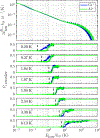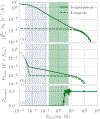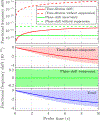Systematic uncertainty due to background-gas collisions in trapped-ion optical clocks
- PMID: 36452133
- PMCID: PMC9706596
- DOI: 10.1103/physreva.100.033419
Systematic uncertainty due to background-gas collisions in trapped-ion optical clocks
Abstract
We describe a framework for calculating the frequency shift and uncertainty of trapped-ion optical atomic clocks caused by background-gas collisions, and apply this framework to an 27Al+ clock to enable a total fractional systematic uncertainty below 10-18. For this clock, with 38(19) nPa of room-temperature H2 background gas, we find that collisional heating generates a non-thermal distribution of motional states with a mean time-dilation shift of order 10-16 at the end of a 150 ms probe, which is not detected by sideband thermometry energy measurements. However, the contribution of collisional heating to the spectroscopy signal is highly suppressed and we calculate the BGC shift to be -0.6(2.4) × 10-19, where the shift is due to collisional heating time dilation and the uncertainty is dominated by the worst case ±π/2 bound used for collisional phase shift of the 27Al+ superposition state. We experimentally validate the framework and determine the background-gas pressure in situ using measurements of the rate of collisions that cause reordering of mixed-species ion pairs.
Figures







References
-
- Li R, Gibble K, and Szymaniec K, Metrologia 48, 283 (2011).
-
- Guena J, Abgrall M, Rovera D, Laurent P, Chupin B, Lours M, Santarelli G, Rosenbusch P, Tobar ME, Li R, Gibble K, Clairon A, and Bize S, IEEE Trans. Ultrasonics Ferroelectrics Freq. Control 59, 391 (2012). - PubMed
-
- Gibble K, Phys. Rev. Lett. 110, 180802 (2013). - PubMed
-
- McGrew WF, Zhang X, Fasano RJ, Schäffer SA, Beloy K, Nicolodi D, Brown RC, Hinkley N, Milani G, Schioppo M, Yoon TH, and Ludlow AD, Nature (London) 564, 87 (2018). - PubMed
-
- Bothwell T, Kedar D, Oelker E, Robinson JM, Bromley SL, Tew WL, Ye J, and Kennedy CJ, arXiv:1906.06004.
Grants and funding
LinkOut - more resources
Full Text Sources
Research Materials
Miscellaneous
